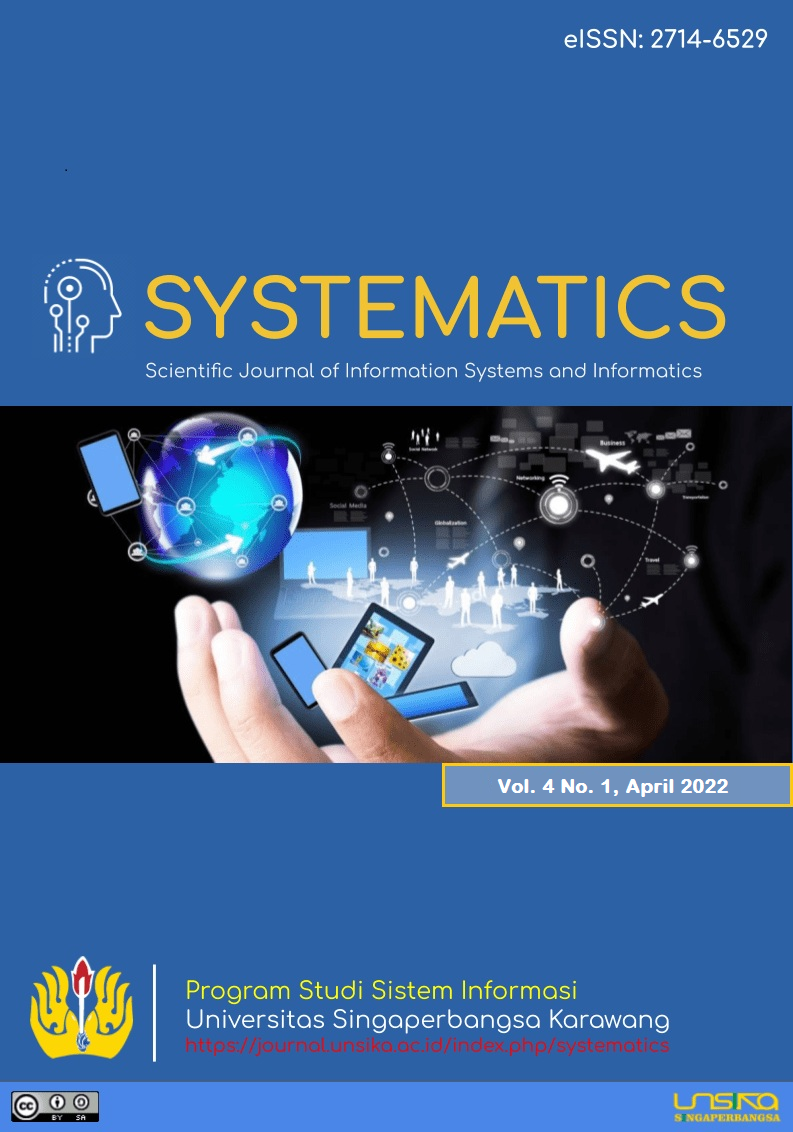Implementation Of E-Commerce With Business Model Canvas (BMC) Method To Increase Sales In Detak Original Store
Implementasi E-Commerce Dengan Metode Business Model Canvas (BMC) Untuk Meningkatkan Penjualan Di Detak Original Store
DOI:
https://doi.org/10.35706/sys.v4i1.6386Abstract
Detak Original store is engaged in selling men's clothing products that have physical stores in Tanah Abang and online sales in marketplaces such as Tokopedia, Lazada, Shopee, and social media Instagram. Problems that occur are a lot of competition in the current marketplace during the Covid-19 pandemic, decreased revenue in physical stores as a result of the difficulty of direct sales during the pandemic, less than optimal sales promotion so that old goods are difficult to sell, lack of detailed product information so that customers become hesitant to buy products via the marketplace and Instagram. Other problems are less than optimal in finding sales report data because the products are similar to one another. Therefore, Detak Original wants to create its own website with an E-commerce system to maximize sales. The method used in building a new E-Commerce business is the Business Model Canvas (BMC) method, and system design using UML and a website with Wordpess-based Content Management System (CMS). This research resulted in an E-Commerce website with various available features to facilitate the long distance buying and selling process. By easily accessing the E-Commerce website, the buying and selling process will be effective and efficient to connect with the public and increase sales.
Downloads
References
R. R. Rerung, E-Commerce, Menciptakan Daya Saing Melalui Teknologi Informasi. Deepublish, 2018.
E. Turban, J. Outland, D. King, J. K. Lee, T.-P. Liang, dan D. C. Turban, Electronic Commerce 2018 : a Managerial and Social Networks Perspective. Springer, 2017.
V. Vysotska, V. B. Fernandes, dan M. Emmerich, “Web Content Support Method in Electronic Business Systems.,” in COLINS, 2018, hal. 20–41.
H. Stern, D. Damstra, dan B. Williams, Professional WordPress : Design and Development. Indianapolis, Indiana: Wiley Publishing, 2010.
E. Oley, S. R. Sentinuwo, dan A. A. E. Sinsuw, “Sistem Pemesanan Makanan Dan Minuman Berbasis Website (Studi Kasus Taipan Restoran),” J. Tek. Elektro dan Komput., vol. 6, no. 4, hal. 159–170, 2017.
Y. Yuliani, M. D. Syahrial, M. A. Ghani, Yusti Farlina, A. Wibowo, dan ..., “Perancangan Program E-Commerce Pakaian (Studi Kasus: Chinot Collection Sukabumi),” J. Speed – Sentra Penelit. Eng. dan Edukasi, vol. 13, no. 1, hal. 54–58, 2020, [Daring]. Tersedia pada: http://speed.web.id/jurnal/index.php/speed/article/view/683.
S. Anwar, Y. D. Romadhoni, dan T. Murni, “Penerapan B2C Sistem Informasi E-Commerce Pada Toko Pakaian Gayaku,” in Konferensi Nasional Ilmu Sosial & Teknologi (KNiST), 2017, hal. 467–472.
F. Alfiah et al., “Perancangan Sistem E – Commerce Untuk Penjualan Pakaian Pada Toko A & S,” vol. 6, no. 1, hal. 70–81.
A. U. Hamdani dan A. Himawan, “Implementasi Model E-Commerce Untuk Meningkatkan Penjualan Pakaian Menggunakan Content Management System , Search Engine Optimization Dan Strategi Marketing 4P,” Idealis, vol. 3, no. 2, hal. 49–55, 2020.
B. Huda dan B. Priyatna, “Penggunaan Aplikasi Content Management System (CMS) Untuk Pengembangan Bisnis Berbasis E-commerce,” Systematics, vol. 1, no. 2, hal. 81, 2019, doi: 10.35706/sys.v1i2.2076.
T. Al Mudzakir dan A. Bakar, “Desain Dan Implementasi Customer Relationship Management Berbasis Web (Studi Kasus : Toko Baju Ladya),” Systematics, vol. 2, no. 1, hal. 1, 2020, doi: 10.35706/sys.v2i1.3444.
A. Osterwalder dan Y. Pigneur, Business model generation: a handbook for visionaries, game changers, and challengers. John Wiley & Sons, 2010.
Downloads
Published
How to Cite
Issue
Section
License
Copyright (c) 2022 SYSTEMATICS

This work is licensed under a Creative Commons Attribution-ShareAlike 4.0 International License.
Authors who publish with this journal agree to the following terms:
- Authors retain copyright and grant the journal right of first publication with the work simultaneously licensed under a Creative Commons Attribution-ShareAlike 4.0 International License. that allows others to share the work with an acknowledgement of the work's authorship and initial publication in this journal.
- Authors are able to enter into separate, additional contractual arrangements for the non-exclusive distribution of the journal's published version of the work (e.g., post it to an institutional repository or publish it in a book), with an acknowledgement of its initial publication in this journal.
- Authors are permitted and encouraged to post their work online (e.g., in institutional repositories or on their website) prior to and during the submission process, as it can lead to productive exchanges, as well as earlier and greater citation of published work (See The Effect of Open Access).







